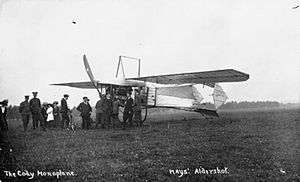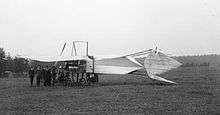Cody monoplane
| Cody IV | |
|---|---|
 | |
| Role | Experimental aircraft |
| National origin | United Kingdom |
| Designer | Samuel Franklin Cody |
| First flight | 21 June 1912 |
| Number built | 1 |
The Cody IV monoplane was a single-engined monoplane designed and built by the American-born but British-based aviation pioneer in 1912. It was intended for entry into the 1912 British Military Aeroplane Competition, but was wrecked in a crash before the start of the competition.
Design and development
In December 1911 the British War Office announced a competition for a Military aeroplane capable of carrying a pilot and observer for the recently established Royal Flying Corps. First prize was £4,000, with the War Office having the option to purchase any of the prize winning machines.[1][2]

The American showman and aviation pioneer Samuel Cody, who had developed a system of man-carrying kites from 1901, built his first aircraft, the British Army Aeroplane No 1 at the Army Balloon Factory at Farnborough in 1908, making its first flight, recognised as the first powered controlled flight in the United Kingdom on 16 October 1908.[3] In order to compete for the prize money offered by the War Office, Cody decided to design and build a new monoplane, while also entering his existing biplane that had finished fourth in the 1911 Daily Mail Circuit of Britain Air Race.[4][5]
Cody's previous designs were pusher canard biplanes, but the new aircraft was a tractor high-winged monoplane powered by a single 120 hp (89 kW) Austro-Daimler engine which had been fitted to an Etrich Taube which had crashed during the 1911 Circuit of Britain, which Cody had purchased after the race.[4] It had a deep fuselage that accommodated the crew of two side-by-side. The tail arrangement was unusual, with two elevators and two rudders carried on four bamboo booms that led back from the fuselage, the all moving tail surfaces forming a box shape. Fabric was stretched between the tail booms giving a cruciform shape as seen in cross-section. Lateral control was by means of wing warping, and the aircraft was fitted with a nosewheel undercarriage.[4][5][6]
Operational history
The monoplane made its maiden flight on 21 June 1912,[5] but on 8 July a cow ran into the path of the aircraft during landing. The resulting crash badly damaged the aircraft and killed the cow, although Cody was not badly injured.[4] As the Circuit of Britain aircraft had already been wrecked in a crash, Cody used the engine from the monoplane together with what parts he could salvage from the biplane to construct a new aircraft, the Cody V biplane, which won the Military Aeroplane Competition.[7]
Specifications
Data from The Aeroplanes of the Royal Flying Corps (Military Wing)[8]
General characteristics
- Crew: 2
- Length: 37 ft (11 m)
- Wingspan: 43 ft 6 in (13.26 m)
- Height: 12 ft 6 in (3.81 m) [9]
- Wing area: 260 sq ft (24 m2)
- Empty weight: 1,400 lb (635 kg)
- Powerplant: 1 × Austro-Daimler water-cooled six-cylinder inline engine, 120 hp (89 kW)
- Propellers: 2-bladed Chauviere [9], 11 ft 6 in (3.51 m) diameter
Performance
- Maximum speed: 70 mph (113 km/h; 61 kn)
Notes
References
- Bruce, J.M. The Aeroplanes of the Royal Flying Corps (Military Wing). London:Putnam, 1982. ISBN 0-370-30084-X.
- Jarrett, Philip. "Cody and His Aeroplanes:Samuel Franklin Cody:His Life and Times". Air Enthusiast, No. 82, July/August 1999. pp. 6–17. Stamford, UK:Key Publishing. ISSN 0143-5450.
- "The Cody Monoplane". Flight, 29 June 1912. pp. 579–583.
- "The War Office Competition". Flight, 23 December 1911, p. 1109.